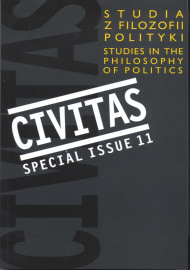The Rule of Freedom
The Rule of Freedom
Author(s): Zbigniew StawrowskiSubject(s): Philosophy
Published by: Instytut Studiów Politycznych PAN
Keywords: Liberty; freedom; liberalism; democracy; Thomas Hobbes; the minimum state model
Summary/Abstract: How can liberty be implemented through state institutions? And what kind of liberty are we thinking about in the contemporary world, since this concept is generally acknowledged as ambiguous? In order to understand the modern state as a rule of liberty, one must investigate the essence of liberty itself. It is widely known that liberty can be viewed in many ways, but what kind of liberty can govern the contemporary political order? Among the philosophers who have examined authority from the point of view of liberty is Benjamin Constant, who has distinguished liberty understood as personal security from liberty recognized as participation in political life, and who has likewise stressed that these two understandings of liberty are complementary. Another widely known vision of freedom is the division of liberty into negative and positive; the latter, in Berlin’s original understanding of the term, remains unclear. Such doubts however do not apply to the negative concept of liberty, as Berlin called it, or its equivalent in Constant’s understanding of liberty understood as personal security. Both authors concur that this understanding of liberty is fundamental, and should above all find its expression in contemporary state institutions. In order to reveal the logic of liberty thus understood, we must turn to its very roots; that is, to Thomas Hobbes’s concept of liberty. For it is Hobbes who first precisely defined that understanding of liberty, and who first consciously engaged in designing a state based from start to finish on the liberty of the individual.
Journal: Civitas. Studia z filozofii polityki
- Issue Year: 2009
- Issue No: 11
- Page Range: 253-267
- Page Count: 15
- Language: English

